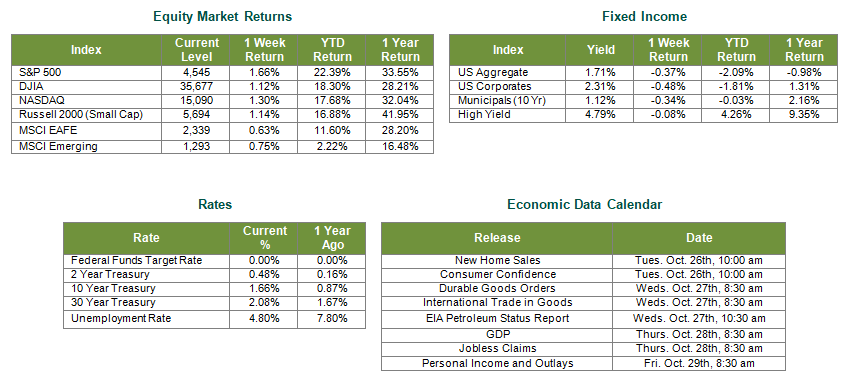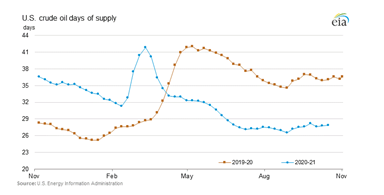
Last Week’s Markets in Review: Paying more at the Pump

Global equity markets finished lower for the week. In the U.S., the S&P 500 Index traded higher in each of this week’s sessions and closed the week at a level of 4,545, representing a gain of 1.66%, while the Russell Midcap Index moved 2.03% higher last week. Meanwhile, the Russell
2000 Index, a measure of the Nation’s smallest publicly traded firms, returned 1.14% over the week. International equity performance was also higher as developed and emerging markets returned 0.63% and 0.75%, respectively. Finally, the 10-year U.S. Treasury yield ticked higher, closing the week at 1.66%.
Oil futures rose last week as continued supply and demand imbalances have pushed prices higher. In fact, as of Friday, the prices of Brent and Crude Oil traded at levels of $85.36 and $84.64, respectively, representing levels that have not been seen in 7 years. As a result, Americans are now paying more at the pump than they have since October of 2014. According to AAA, the average national price of regular-grade gasoline is currently $3.369/gallon which translates to a 55% increase from the same time last year when average prices were just $2.164/gallon. In previous weeks we have stressed concerns about inflation and whether it may be transitory or not. Gasoline prices may be the asset class individuals feel the negative effects of such phenomenon the most, but are these high prices here to stay?
The prices of oil and gasoline, like other commodities, are driven by supply and demand factors. As the global economy continues to ramp back up, demand for these commodities rises and without the supply to fulfill this demand, prices will continue to rise. As of October 4th, the Organization of the Petroleum Exporting Countries Plus (OPEC+), which regulates oil supply to help provide global market price stability, stated that they would keep current production targets unchanged. These production estimates are projected to be an increase of 400,000 barrels per month while consensus estimates forecast increased demand between 500,000 and 1,000,000 barrels per month, creating an even greater market imbalance. Additionally, according to the EIA Weekly Petroleum Status report, Crude Oil inventories have now shrunk to 6% below their 5-year average with the current days of supply at 27.9, representing a 29% decrease from a year ago.

With the increasing demand for oil and diminishing supply of it, it would be no surprise to have prices of such commodities continue to rise in the short to medium term. However, it is important to note that OPEC+ has the capacity to increase production and could do so if prices get too high, similar to how central banks help control inflation through monetary policy. If supply chain constraints can subside, and production increases, these high prices should subside over time.
While the basis of this update has focused on the commodities market, we believe it prudent to also take time to mention what we have already seen in Q3 earnings. As of Friday, 117 companies within the S&P 500 index had reported Q3 earnings with just over 81% reporting earnings surprises with an average beat of 13.05%, according to Bloomberg. Additionally, all 11 market sectors have posted positive earnings growth thus far. With just under 25% of companies reporting, the early snapshot of earnings season is off to a great start as the U.S. economy continues to show its resilience as the U.S. moves through the COVID-19 pandemic.
We will continue to monitor the commodities market, earnings releases and their implications on the global economy and portfolio strategies that we manage. As always, we encourage investors to speak with financial professionals to determine that portfolios are being managed in accordance to risk tolerance, timeframe and objectives. Best wishes for the week ahead!
Equity Market and Fixed Income returns are from JP Morgan as of 10/22/21. Rates and Economic Calendar Data from Bloomberg as of 10/22/21. International developed markets measured by the MSCI EAFE Index, emerging markets measured by the MSCI EM Index, U.S. Large Cap defined by the S&P 500. Sector performance is measured using the GICS methodology.
Disclosures: Past performance does not guarantee future results. We have taken this information from sources that we believe to be reliable and accurate. Hennion and Walsh cannot guarantee the accuracy of said information and cannot be held liable. You cannot invest directly in an index. Diversification can help mitigate the risk and volatility in your portfolio but does not ensure a profit or guarantee against a loss.
Diversification can help mitigate the risk and volatility in your portfolio but does not ensure a profit or guarantee against loss.
Investing in commodities is not suitable for all investors. Exposure to the commodities markets may subject an investment to greater share price volatility than an investment in traditional equity or debt securities. Investments in commodities may be affected by changes in overall market movements, commodity index volatility, changes in interest rates or factors affecting a particular industry or commodity.
Products that invest in commodities may employ more complex strategies which may expose investors to additional risks.
Investing in fixed income securities involves certain risks such as market risk if sold prior to maturity and credit risk especially if investing in high yield bonds, which have lower ratings and are subject to greater volatility. All fixed income investments may be worth less than the original cost upon redemption or maturity. Bond Prices fluctuate inversely to changes in interest rates. Therefore, a general rise in interest rates can result in the decline of the value of your investment.
Definitions
MSCI- EAFE: The Morgan Stanley Capital International Europe, Australasia and Far East Index, a free float-adjusted market capitalization index that is designed to measure developed-market equity performance, excluding the United States and Canada.
MSCI-Emerging Markets: The Morgan Stanley Capital International Emerging Market Index, is a free float-adjusted market capitalization index that is designed to measure the performance of global emerging markets of about 25 emerging economies.
Russell 3000: The Russell 3000 measures the performance of the 3000 largest US companies based on total market capitalization and represents about 98% of the investible US Equity market.
ML BOFA US Corp Mstr [Merill Lynch US Corporate Master]: The Merrill Lynch Corporate Master Market Index is a statistical composite tracking the performance of the entire US corporate bond market over time.
ML Muni Master [Merill Lynch US Corporate Master]: The Merrill Lynch Municipal Bond Master Index is a broad measure of the municipal fixed income market.
Investors cannot directly purchase any index.
LIBOR, London Interbank Offered Rate, is the rate of interest at which banks offer to lend money to one another in the wholesale money markets in London.
The Dow Jones Industrial Average is an unweighted index of 30 “blue-chip” industrial U.S. stocks.
The S&P Midcap 400 Index is a capitalization-weighted index measuring the performance of the mid-range sector of the U.S. stock market, and represents approximately 7% of the total market value of U.S. equities. Companies in the Index fall between S&P 500 Index and the S&P SmallCap 600 Index in size: between $1-4 billion.
DJ Equity REIT Index represents all publicly traded real estate investment trusts in the Dow Jones U.S. stock universe classified as Equity REITs according to the S&P Dow Jones Indices REIT Industry Classification Hierarchy. These companies are REITs that primarily own and operate income-producing real estate.



